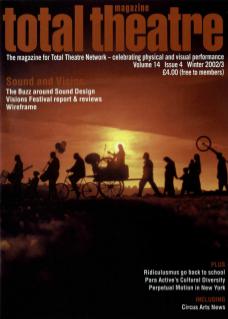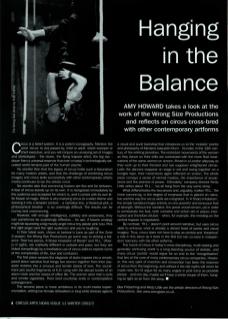A circus is a belief system. It is a potent iconography. Mention the word 'circus' to any passer-by, child or adult, street sweeper or chief executive, and you will conjure an unvarying set of images and stereotypes – the clown, the flying trapeze artist, the big top – drawn from a universal reservoir that even in today's technologically saturated world remains part of the human psyche.
No wonder then that the legacy of circus holds such a fascination for many modern artists, and that the challenge of combining circus imagery and circus skills successfully with other contemporary artistic media continues to tax the artistic mind.
No wonder also that convincing fusions are few and far between. A feat of circus stands up on its own. It is recognised immediately by the audience and accepted for what it is, and it comes with its own little frisson of magic. Which is why marrying circus to a wider theme and drawing it into a broader context – a narrative line, a theatrical plot, a philosophical treatise – is so unerringly difficult. The results can be clumsy and unconvincing.
However, with enough intelligence, subtlety and awareness, they can sometimes be surprisingly effective... An apt, if bizarre analogy might be squeezing a big muscly angel into a tiny plastic pink tutu. Pick the right angel (and the right audience) and you're laughing. In their latest work, shown at Jacksons Lane as part of the Zone 3 season, the Wrong Size Productions go some way to striking a balance. Their two pieces, A Sharp Inhalation of Breath and PIL (Poetry in Light), are markedly different in outlook and pace, but they are linked compellingly by a meditative use of circus skills to explore some of the complexities of life, love and confusion.
The first piece weaves the elegance of static trapeze into a simple, pared-down narrative that brings two women together from their separate reveries into a sinuous and tender dance of love. The soundtrack jars soulful fragments of k.d. lang with the abrupt bursts of an alarm clock and the noises of office life. The women wear men's suits and smoke cigarettes. Their brief courtship ends in contemplative estrangement.
The second piece is more ambitious in its multimedia experimentation, setting two female stiltwalkers in long white dresses against a visual and aural backdrop that introduces us to the 'ecstatic' poetry and philosophy of Mevlana Jalauddin Rumi – founder, in the 13th Century, of the whirling dervishes. The restricted movements of the women as they dance on their stilts are contrasted with the more fluid incarnations of the same women on screen, filmed in a London alleyway as they work up to their frenzied and (we suppose) enlightened climax. Later the dancers reappear on stage in red and swing together on a bungee rope, their movements again reflected on screen. The whole piece conveys a sense of eternal mystery, the importance of acceptance and the promise of peace. 'Ultimately,' company director Kirsty Little writes about PIL, ‘we all hang from the very same strop’.
What differentiates the two pieces and, arguably, makes PIL the more convincing, is the degree of emphasis that is placed on narrative and the way the circus skills are integrated. In A Sharp Inhalation, the simple narrative hinges entirely on one powerful and sensuous feat of strength. Without the narrative, the power would remain, yet in order to orchestrate the feat, both narrative and action are in places interrupted and therefore diluted – when, for example, the meeting on the central trapeze is negotiated.
By contrast, PIL doesn't pivot around narrative, but uses circus skills to enhance what is already a vibrant feast of poetic and visual imagery. Thus, circus does not have to play as central and theatrical a role in this piece as it does in the first but can co-exist in independent harmony with the other artforms.
The future of circus in today's cross-disciplinary, multi-tasking and generally confusing world is a long-standing source of debate, and many circus 'purists' would argue for an end to the 'mongolisation' that lies at the core of many contemporary circus companies. However, this very spirit of invention and reinvention has been the essence of circus from the beginning, and without it the old myths will never be made new. So I'd argue for as many angels in pink tutus as possible please – and one day, maybe we'll have a whole troupe of them, hanging as light as air from the strop.
Bea Fritzsching and Kirsty Little are the artistic directors of Wrong Size Productions. See www.wrongsize.co.uk

